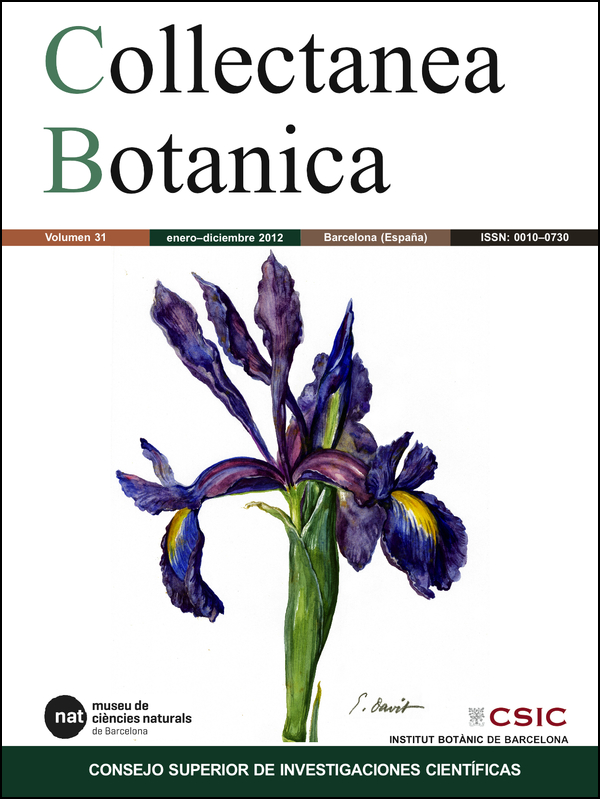La diversificación de las cícadas y la biodiversidad tropical
DOI:
https://doi.org/10.3989/collectbot.2012.v31.008Palabras clave:
cambio climático, cronología de especiación, Cycadales, gradientes latitudinales de biodiversidad, paleobiogeografíaResumen
El reciente e inesperado descubrimiento de que las Cycadales actuales no son relictos Jurásico-Cretácicos (200-65 Mya), ya que todos sus géneros iniciaron su diversificación durante el Mioceno Tardío (12 Mya), ha puesto en entredicho un mito evolutivo clásico. En esta nota se expone como este hallazgo puede, además, proporcionar nuevas pistas sobre el origen de la elevada biodiversidad tropical.
Descargas
Citas
Hoorn, C., Wesselingh, F. P., ter Steege, H. et al. 2010. Amazonia through time: Andean uplift, climate change, landscape evolution, and biodiversity. Science 330: 927-931. http://dx.doi.org/10.1126/science.1194585 PMid:21071659
Hoorn, C., Wesselingh, F. P., Ter Steege, H. et al. 2011. Origins of Biodiversity–Response. Science 331: 399-400. http://dx.doi.org/10.1126/science.331.6016.399
Janssens, S. B., Knox, E. B., Huysmans, S., Smets, E. F. & Merckx, V. S. F. T. 2009. Rapid radiation of Impatiens (Balsaminaceae) during Pliocene and Pleistocene: Result of a global climate change. Mol. Phylogenet. Evol. 52: 806-824. http://dx.doi.org/10.1016/j.ympev.2009.04.013 PMid:19398024
MacColl, A. D. C. 2011. The ecological causes of evolution. Trends Ecol. Evol. 26: 514-522. http://dx.doi.org/10.1016/j.tree.2011.06.009 PMid:21763030
Mittelbach, G. G., Schemske, D. W., Cornell, H. V. et al. 2007. Evolution and the latitudinal diversity gradient, speciation, extinction and biogeography. Ecol. Lett. 4: 315-331. http://dx.doi.org/10.1111/j.1461-0248.2007.01020.x PMid:17355570
Mullen, S. P., Savage, W. K., Wahlberg, N. & Willmott, K. R. 2011. Rapid diversification and not clade age explains high diversity in neotropical Adelpha butterflies. Proc. R. Soc. B 278: 1777-1785. http://dx.doi.org/10.1098/rspb.2010.2140 PMid:21106589 PMCid:3097834
Nagalingum, N. S., Marshall, C. R., Quental, T. B., Rai, H. S., Little, D. P. & Mathews, S. 2011. Recent synchronous radiation of a living fossil. Science 334: 796-799. http://dx.doi.org/10.1126/science.1209926 PMid:22021670
Renner, S. S. 2011. Living fossil younger than thought. Science 334: 766-767. http://dx.doi.org/10.1126/science.1214649 PMid:22076366
Rull, V. 2008. Speciation timing and neotropical biodiversity, the Tertiary-Quaternary debate in the light of molecular phylogenetic evidence. Mol. Ecol. 17: 2722-2729. http://dx.doi.org/10.1111/j.1365-294X.2008.03789.x PMid:18494610
Rull, V. 2011a. Origins of biodiversity. Science 331: 398-299. http://dx.doi.org/10.1126/science.331.6016.398-c PMid:21273468
Rull, V. 2011b. Neotropical biodiversity: timing and potential drivers. Trends Ecol. Evol. 26: 508-513. http://dx.doi.org/10.1016/j.tree.2011.05.011 PMid:21703715
Rull, V. 2012. Palaeobiodiversity and taxonomic resolution: linking past trends with present patterns. J. Biogeogr. 39: 1005-1006. http://dx.doi.org/10.1111/j.1365-2699.2012.02735.x
Valente, L. M., Savolainen, V. & Vargas, P. 2010. Unparalleled rates of species diversification in Europe. Proc. R. Soc. B 277: 1489-1496. http://dx.doi.org/10.1098/rspb.2009.2163 PMid:20106850 PMCid:2871840
Weir, J. T. & Schluter, D. 2007. The latitudinal gradient in recent speciation and extinction rates of birds and mammals. Science 315: 1574-1576. http://dx.doi.org/10.1126/science.1135590 PMid:17363673
Wesselingh, F. P., Hoorn, C., Kroonenberg, S. B., Antonelli, A., Lundberg, J. G., Vonhof, H. B. & Hooghiemstra, H. 2010. On the origin of Amazonian landscapes and biodiversity, a synthesis. In: Hoorn, C. & Wesselingh, F. (Eds.), Amazonia, landscape and species evolution. Wiley-Blackwell, Oxford: 421-431.
Descargas
Publicado
Cómo citar
Número
Sección
Licencia
Derechos de autor 2012 Consejo Superior de Investigaciones Científicas (CSIC)

Esta obra está bajo una licencia internacional Creative Commons Atribución 4.0.
© CSIC. Los originales publicados en las ediciones impresa y electrónica de esta Revista son propiedad del Consejo Superior de Investigaciones Científicas, siendo necesario citar la procedencia en cualquier reproducción parcial o total.
Salvo indicación contraria, todos los contenidos de la edición electrónica se distribuyen bajo una licencia de uso y distribución “Creative Commons Reconocimiento 4.0 Internacional ” (CC BY 4.0). Consulte la versión informativa y el texto legal de la licencia. Esta circunstancia ha de hacerse constar expresamente de esta forma cuando sea necesario.
No se autoriza el depósito en repositorios, páginas web personales o similares de cualquier otra versión distinta a la publicada por el editor.














